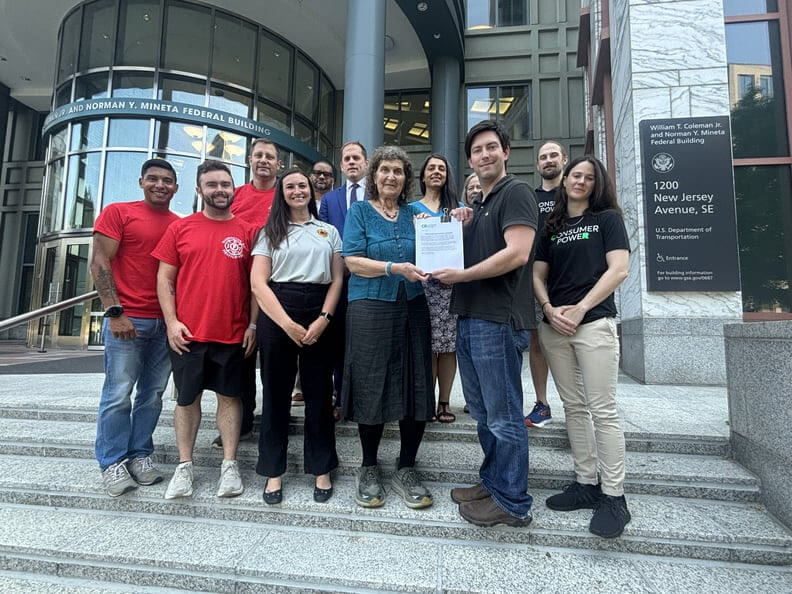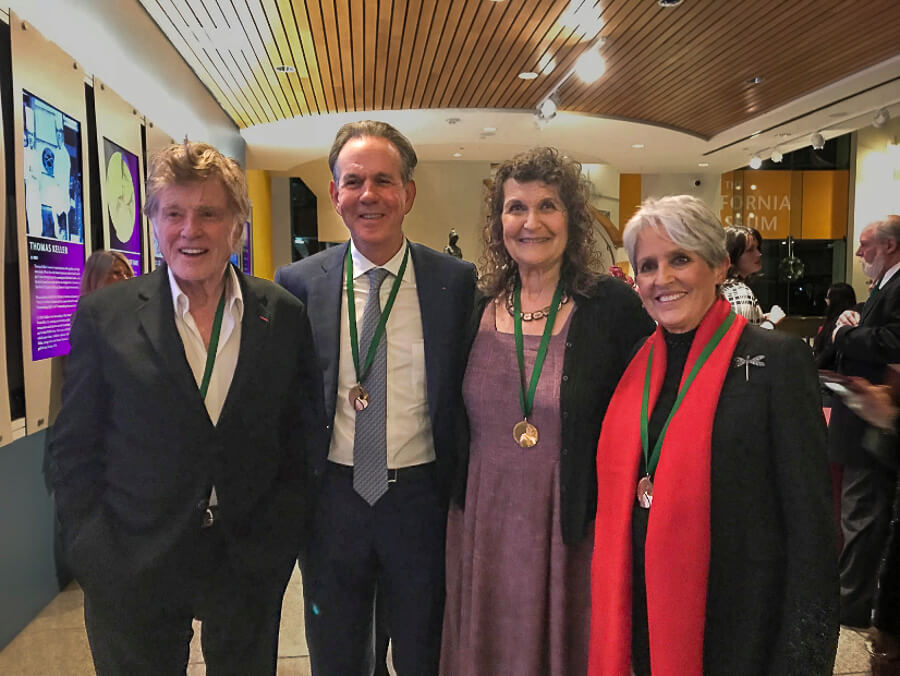October 2025: Are Antimicrobials the Next PFAS?
In this edition:
- Explore Our Forbes Sustainability Articles
- Flame Retardants Beware! No Longer in Our Couches—But Still in Our Cars!
- Cancer Concerns Over Hair Straighteners
- Reenvisioning the Chemical Industry
- A Tribute to Jamie Redford and Kirby Walker
- Green Science Policy Institute in the News
- Calendar
I hope you are enjoying the crisp mornings and cozy evenings of October.
I am just back from a surprisingly fruitful trip to Washington, D.C. Anna Soehl from the Institute, a colleague from the International Association of Firefighters (IAFF), and I met with Senate and House staff who are hard at work despite the ongoing shutdown. A key focus of those meetings was updating the federal vehicle flammability standard that drives the use of unnecessary flame retardant chemicals inside of our cars.
Happily, offices from both parties are interested in solving this problem by directing the National Highway Traffic Safety Administration (NHTSA) to evaluate and research improving the 54-year-old standard—critical first steps towards safer and healthier vehicles..
Before the D.C. trip, we also made progress with our project on antimicrobials (such as those used in antibacterial hand soap, cleaning products, and disinfectant wipes) by hosting an in-person “Information Exchange” meeting. This brought together representatives from most of the major soap and cleaning brands that use antimicrobials, scientists, government, NGOs, and antimicrobial manufacturers. After hiking and a memorable sunset dinner by the Bay, we gathered from very different viewpoints to learn from one another.
The brands and industry participants shared their perspectives and then heard from academic scientists about the latest research on the risks of these chemicals, from mitochondrial toxicity to antimicrobial resistance. We’ve seen how our model of respectfully sharing good science with manufacturers can lead to positive change. Previously, food packaging and carpet companies moved away from PFAS after similar meetings. A good time was had by all and we hope that one or more forward-thinking companies will follow this example and move towards functional and healthier products—without antimicrobials.

Earlier this month, I enjoyed being interviewed by Outdoor Minimalist, a podcast exploring the parallels between adventure and advocacy. I have spoken on this podcast before about PFAS or forever chemicals, but this time our conversation was entitled "Are Antimicrobials the new PFAS?" We began by drawing parallels between high altitude mountaineering and reducing chemical harm and then discussed the class concept and antimicrobials. Please consider giving this podcast a listen!
Also, while in Washington, D.C., I was honored to present the opening keynote address for the 100th anniversary of the founding of the Society of Women Geographers in 1925—a time when women were excluded from membership in many professional organizations such as the Explorers Club. Please contact me if you might be interested in joining this society of mutual support for women who explore, travel, research or write in geography or a related field.
Last month I was saddened to learn of Robert Redford’s passing. Robert was a great actor, director, and producer, and also a dedicated environmentalist. I was honored to be inducted into the California Hall of Fame in 2018 alongside Robert Redford, Joan Baez, and others. Robert and I spoke about the powerful film Toxic Hot Seat, made by his son Jamie Redford and Kirby Walker.
That documentary exposed the dangers of toxic flame retardants in furniture and baby products and helped inspire our Institute's work which contributed to healthy, fire-safe products without these harmful chemicals. See my tribute to Jamie Redford and Kirby Walker below.
Best wishes for the fall season,
Arlene and the Green Science Policy team
Explore Our Forbes Sustainability Articles
You might enjoy our series of articles in Forbes Sustainability. We have been writing about reducing the use of harmful chemicals for Forbes since December 2024 and appreciate this opportunity to reach those in the business and corporate sustainability world who could have the influence to translate our science into positive change.
A couple of favorite articles to check out are Your Favorite Disinfectant Wipes Could Do More Harm Than Good and Your Pet’s Topical Flea Treatments Harm Wildlife.
For further archived talks and writings from our Institute, visit our YouTube channel and our publications.
Flame Retardants Beware! No Longer in Our Couches—But Still in Our Cars!
With Halloween coming up, here’s a spooky couch graphic from years past. The skulls represent the toxic flame retardants that were added to furniture foam across the U.S. beginning in 1976 to meet an ineffective California furniture flammability standard. You can learn more in an informative Retro Report from the New York Times.

After years of research and advocacy by our Institute and others, in 2014, California updated its standard to increase fire safety with flame retardants no longer needed by stopping most fires in fabric before they reached the flammable foam. And in 2021, the updated California standard was adopted as a federal furniture flammability standard for the entire country. Great news for both healthy homes and fire safety!
However, flame retardants are still added to foam used in seats and elsewhere inside motor vehicles. Last year we published a study with Duke University finding harmful flame retardants in 101 cars from 22 brands we studied. The chemicals are needed to meet the U.S. National Highway Traffic Safety Administration (NHTSA) Federal Motor Vehicle Safety Standard (FMVSS) 302. This flammability standard that was introduced in 1971 when smoking while driving was common. Although it has never been proven to save lives, this standard has led to toxic chemical exposures in vehicles for 54 years.
Along with Consumer Reports and the International Association of Fire Fighters, we have petitioned NHTSA to update this standard—similar to what California did for furniture—so that unnecessary flame retardants would no longer be used inside our cars. To learn more and for tips for reducing your exposure, see our webpage.
Cancer Concerns Over Hair Straighteners
By Carolyn Said
Women have long felt pressure to alter their natural hair texture—often using chemicals that can harm their health. Chemical hair straighteners and relaxers have been linked to breast, uterine, and ovarian cancers, as well early puberty and other hormone-related health problems. Because about 89% of black women report using these products, they face the greatest risk, making this an environmental justice issue. Now, new research from Emory University finds that frequent use of hair straighteners or relaxers—defined as four or more times per year—is additionally associated with higher rates of pancreatic cancer, thyroid cancer, and non-Hodgkin’s lymphoma.
The findings, published in the Journal of the National Cancer Institute, are based on data from more than 40,000 American women. Researchers followed participants for an average of 13 years to understand the long-term health effects of hair straighteners and relaxers. “These novel findings expand the scope of the adverse health outcomes that have been associated with these products,” the researchers write.
Parabens and phthalates, both linked to endocrine disruption, are common ingredients in hair straighteners and relaxers. The products also often contain the carcinogen formaldehyde, a preservative that can slowly release gas over time. When exposed to heat—such as from hair dryers, blow dryers, or flat irons—off-gassing increases, raising exposure risks.
Although the Food and Drug Administration moved to ban formaldehyde and formaldehyde-releasing chemicals in hair straighteners in 2023, the ban has faced repeated delays. Fortunately, the states are stepping up: California, Washington, and Maryland have already banned formaldehyde in cosmetics.
These findings point to the need for stronger cosmetic safety laws and for beauty standards that don’t compromise women’s health.
Reenvisioning the Chemical Industry
By Joel Tickner, Green Science Policy Institute Senior Fellow
The chemical industry is at a crossroads. While its products are essential to achieving a high quality of life for the global population, they are also a primary industrial contributor to the climate, toxic pollution, and plastic waste crises that now threaten human and planetary health. The chemical sector needs to undergo a dramatic transformation over the next 20 to 30 years to achieve goals related to net zero greenhouse gas emissions, biodiversity protection, and chemical pollution reduction.

But how can this happen? The Science History Institute (which houses archives of the chemical industry) and the Lowell Center for Sustainable Production hosted the 2025 TT Chao Symposium to explore the government, investment, and private sector actions that created the modern chemical industry and lessons learned from other rapidly changing industries to help shape the sustainable chemical industry of the future.
I led the planning and execution of the symposium and its conclusions are highlighted in a new article in Issues in Science and Technology, the journal of the National Academy of Sciences. The main conclusion of the work is that “a rethink of the industry will need a plan that marries a reconceptualization of its societal goals (seeing sustainability as a performance and innovation goal rather than an enforcement problem) with a combination of crisis-inspired sprint initiatives to solve immediate challenges and long-term industrial planning.”
It will also require massive investment over time and incentives to foster the supply of new chemicals as well as consumer demand. The Science History Institute and Lowell Center are now planning the next TT Chao Symposium for February 2026 focused on the critical issues of financing and global transition of the industry.
A Tribute to Jamie Redford and Kirby Walker
By Arlene Blum
The passing of Robert Redford reminded me of the invaluable contributions and the much too early passing of his son Jamie Redford in 2020 from a rare cancer. Jamie was a good friend and noted film producer and environmentalist who along with Kirby Walker, also an outstanding documentary filmmaker and environmental activist, produced the film Toxic Hot Seat.
The film, featuring the San Francisco firefighter and cancer survivor Tony Stefani, brought the health harm and lack of benefit of flame retardants in furniture to a wide audience, and especially to firefighters. The
firefighters continue to be strong allies-–most recently in supporting changing the outdated federal flammability standard leading to flame retardants in our cars.
Toxic Hot Seat made a critical contribution to changing furniture flammability standards so that now furniture and most children's products are free of these harmful and unneeded chemicals. This means healthier homes for all who have purchased furniture since 2014.
Very sadly, in 2019 Kirby Walker also died of cancer. We want to recognize Jamie and Kirby's important contributions and the heartbreak of the passing of these kind and brilliant friends much too soon. Such tragedies help motivate our current projects to prevent cancer-causing chemicals in our cars and in the plastic cases around lithium ion batteries.
Green Science Policy Institute in the News

By Rebecca Fuoco
Below are recent news articles, blogs, podcasts, newsletters, and more that have featured our Institute’s work and expertise.
- The Guardian mentioned how our joint study on PFAS in school uniforms informed California legislation.
- Arlene talked to the Outdoor Minimalist podcast about antimicrobials and how they may be the next PFAS.
- Willamette Week discussed our Six Classes as chemicals to look out for in home goods.
- In an article for America’s Essential Hospitals, the sustainability director of CanonDesign talks about how our Six Classes website is helping the University of Chicago Medicine avoid using harmful chemicals in building its AbbVie Foundation Cancer Pavilion.
- Arlene explained to Chemical Watch that fluoropolymers have a problematic life cycle because they are made from small-molecule PFAS and can degrade back into these harmful substances over time.
- Urban Land recommended our Six Classes website as a resource for designing indoor spaces to promote brain health.
- Tony Stefani, founder and president of the San Francisco Firefighters Cancer Prevention Foundation, mentioned our work together in an interview with the Fire and Safety Journal Americas.
- This Sierra Club blog links to our PFAS in building materials report.
- This Ecology Center blog notes our PFAS Central website is helpful for learning how to avoid PFAS.
- Green Transition Denmark cited our report finding PFAS in building materials.
Calendar
Wednesday, October 29, 11 AM-12:30 PM Pacific
Arlene Blum will present a webinar for the Outdoor Industry Association: "What's Next? Are Antimicrobials the next PFAS?" She will discuss how scientific research is driving policy changes to phase out harmful chemicals and promote safer alternatives.
Saturday, November 8, 2025, 9 AM – 5 PM Pacific, Santa Monica, California
Great Pacific Garbage Patch TedX
Arlene will speak on "Tackling Toxics in Plastics" along with global experts presenting the latest knowledge and research during the Great Pacific Garbage Patch TedX sponsored by the Plastic Pollution Coalitions at the Annenberg Community Beach House.
Register to join in person or livesteam: https://tedxgreatpacificgarbagepatch.com/
Saturday, November 15, 6:30 PM Pacific, Portland, Oregon
Arlene Blum will present "Breaking Trail: Mountains and Molecules," on her historic mountaineering expeditions and current work reducing the use of harmful flame retardants and antimicrobials in consumer products.
The Mazamas Mountaineering Center, 527 SE 43rd Ave, Portland OR, 97215.
Free. Doors open at 6 PM
More info: https://mazamas.org/activity/instance/14378/
Wednesday, November 19, 2025, 1:30 PM Pacific, Portland, Oregon
Arlene Blum will speak during a session on "The growing interface between science and policy challenges and strategies for making progress" at the Society of Environmental Toxicology and Chemistry North America 46th Annual Meeting.
Her talks are: "The Six Classes Concept and a Strategy Towards a Healthier World" and "Questionable Safety vs. Known Harms: Flame Retardants in Lithium-Ion Battery Enclosures."
More info and abstracts of talks:
https://setac.confex.com/setac/sna2025/meetingapp.cgi/Session/6113
Wednesday, November 19, 2025, 6 PM Pacific, Portland Oregon
Arlene Blum will be speaking to the "Reedies in Sustainability" club at her alma mater from 6-7 PM. Both her environmental work and mountaineering started at Reed and she is very happy to return to share her adventures during her free talk "Breaking Trail: Mountains and Molecules."
Please register for the 7:30-9 reception: Via online form
Vollum Lecture Hall & Lounge, Reed College, 3203 SE Woodstock Blvd, Portland, OR 97202
Receive Updates By Email
Subscribe to our monthly newsletter and get these updates delivered right to your inbox!




